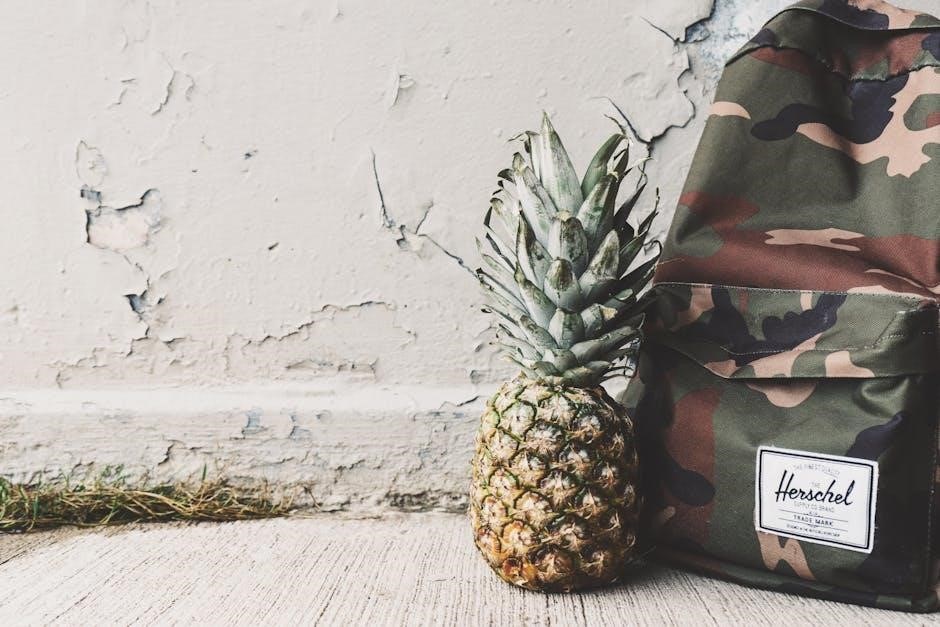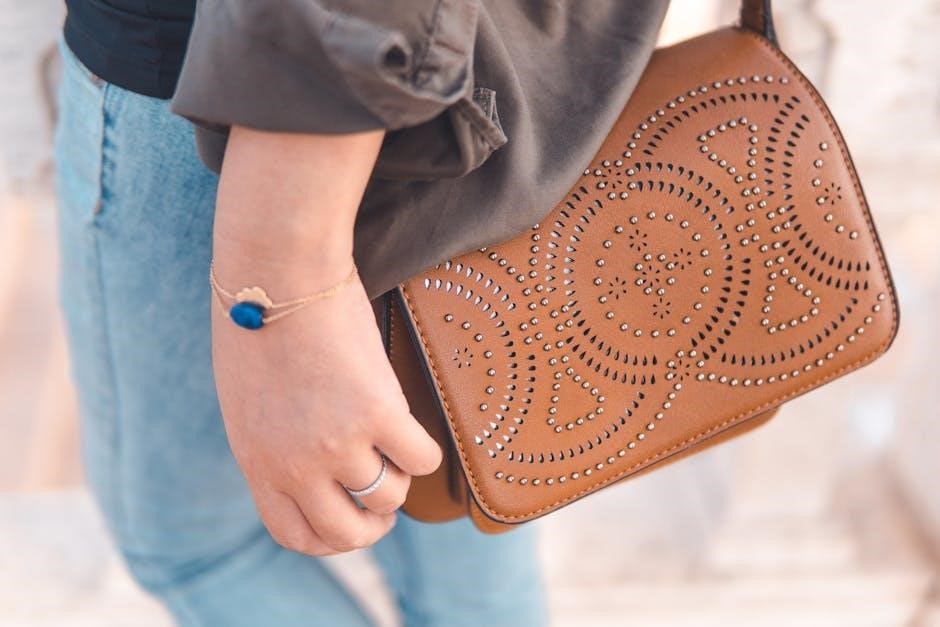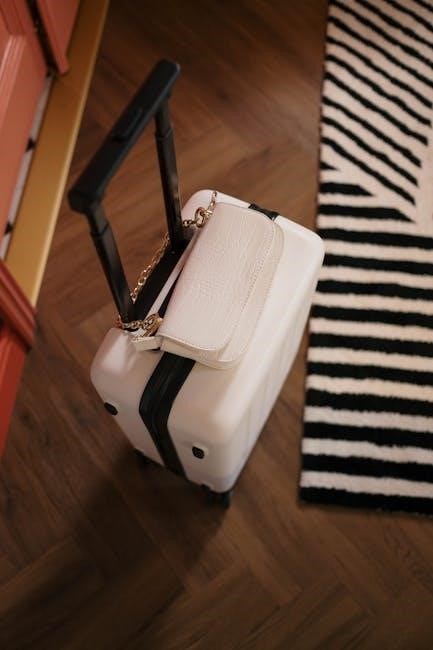Welcome to the world of hobo bag sewing! Discover the joy of creating a stylish, slouchy bag with free PDF patterns. Perfect for beginners and crafty sewists alike, these patterns offer versatility and ease, allowing you to craft a functional and fashionable accessory.
What is a Hobo Bag?
A hobo bag is a stylish, unstructured shoulder bag characterized by its soft, slouchy design and signature crescent shape. Typically crafted from lightweight fabrics, it features a single, long strap and an open-top closure. Known for its bohemian-inspired aesthetic, the hobo bag is a versatile accessory that combines practicality with a laid-back, chic appeal. Its relaxed silhouette allows for a spacious interior, making it ideal for everyday use. Whether in denim, corduroy, or elegant fabrics, the hobo bag is a timeless choice for those who appreciate effortless style and functionality. Its simplicity and comfort have made it a favorite among sewists and fashion enthusiasts alike.
Why Choose a Free PDF Pattern?
Opting for a free PDF pattern is a cost-effective and convenient way to start your hobo bag sewing project. These patterns are easily downloadable and printable, providing instant access to step-by-step instructions. They often include detailed cutting guides and assembly tips, making the sewing process straightforward even for beginners. Many free PDF patterns are designed with simplicity in mind, requiring minimal fabric and materials. This accessibility allows crafters to experiment with different styles and fabrics without financial commitment. Additionally, free patterns frequently come with video tutorials or online support, ensuring a smooth sewing experience. With a free PDF pattern, you can create a professional-looking hobo bag from the comfort of your home.

Materials and Tools Needed
For a hobo bag, you’ll need fabric, lining material, interfacing, and basic sewing tools like scissors, pins, and a sewing machine. Gather these essentials to begin.
Fabric Requirements for a Hobo Bag
For a hobo bag, fabric requirements typically include 1-2 yards of medium-weight fabric, depending on the size and design. Popular choices are cotton, denim, or corduroy for a sturdy yet stylish look. Lightweight fabrics like rayon or linen can create a slouchy, bohemian aesthetic. Ensure the fabric has a soft drape for a natural, relaxed shape. Some patterns recommend contrasting lining fabric for a polished interior. Additionally, interfacing or stabilizer may be needed for structure, especially if using lighter materials. Choose fabrics that complement your personal style, as they will define the bag’s texture and appearance. This step is crucial for achieving the desired look and functionality of your hobo bag.
Notions and Hardware
To complete a hobo bag, gather essential notions and hardware. These typically include a magnetic snap for the closure and sturdy straps or handles. You’ll need thread matching your fabric, along with sewing needles and pins. Interfacing or stabilizer adds structure, while a walking foot or Teflon foot can aid in smooth sewing. Some patterns may require rivets for a professional finish or a removable strap for versatility. Ensure all hardware is durable to support the bag’s weight. Organize your supplies beforehand to streamline the sewing process and achieve a polished, professional result. These small details make a big difference in the functionality and appearance of your hobo bag.

Downloading and Using Free Hobo Bag Patterns
Accessing free hobo bag PDF patterns is easy. Visit reputable sewing websites or platforms like Pinterest and YouTube for downloadable files. Ensure compatibility with your printer and sewing skills.
Where to Find Free Hobo Bag PDF Patterns
Discover a variety of free hobo bag PDF patterns on platforms like Pinterest and YouTube. Websites such as Lanaonline offer patterns made with specific yarns, while PatternPile.com showcases diverse designs. Explore tutorials and downloads on sites like YouTube for step-by-step guides. Many creators share their patterns freely, catering to different skill levels and fabric preferences. Whether you’re looking for a slouchy, denim, or eco-friendly design, these resources provide everything needed to start your project. Download patterns directly from these sites and enjoy crafting your unique hobo bag with ease.
How to Print and Assemble the Pattern
Printing and assembling your free hobo bag PDF pattern is straightforward. Ensure your printer is set to “Actual Size” or “100%” scale to maintain accuracy. Print each page and use the alignment marks to tape the sheets together seamlessly. Some patterns include a test square for scale verification. Once assembled, cut out the pieces carefully. Digital patterns often come with layers or separate files for different sizes, making it easier to customize. Follow the instructions provided with the PDF for specific assembly tips, and you’ll be ready to start cutting your fabric in no time. Proper assembly ensures a professional finish for your bag.

Step-by-Step Sewing Guide
Begin by sewing the bag’s front and back panels together, ensuring straight seams. Attach the sides and bottom, then add the straps securely. Finish the seams for durability.
Cutting Out the Fabric Pieces
Start by printing and assembling your free PDF pattern, ensuring all pieces fit on your fabric. Lay the material flat and carefully cut out the front, back, sides, and strap pieces. Use scissors or a rotary cutter for accuracy; Transfer markings like darts or pocket placements using chalk or a tracing wheel. Cut two main panels, two side panels, and straps, considering any interfacing or lining. Double-check measurements to ensure symmetry and proper fit. Organize your pieces before sewing to streamline the process. This step sets the foundation for a professional-looking hobo bag.
Sewing the Bag Together
Begin by sewing the front and back panels together, aligning edges carefully. Attach the side panels to create the bag’s structure. If using a lining, sew it separately, then place it inside the outer bag. Add pockets by sewing them to the lining before assembling. Fold and press seams for a professional finish. Use a walking foot for heavy fabrics. Topstitch edges for durability and style. Sew the bottom seam, leaving a small opening to turn the bag right side out. Ensure all seams are secure. For a slouchy look, sew the sides with a slight curve. Follow the pattern’s instructions for handle placement and finishing touches. This step brings your hobo bag to life, combining function and style seamlessly.
Adding Handles and Finishing Touches
Once the bag is sewn together, focus on adding the handles for functionality. Cut and sew straps according to the pattern, ensuring they are sturdy and evenly spaced. Attach them securely to the bag’s top edges, using rivets or reinforced stitching for durability. For a polished look, topstitch the seams and handle attachments. Add any embellishments, such as decorative hardware or appliqué, to give your bag a personal touch. Finish the interior by sewing the lining opening closed by hand or machine. Inspect all seams for strength and consistency. Your hobo bag is now complete, ready to be filled with your essentials and enjoyed for years to come.

Customization Ideas
Personalize your hobo bag with unique fabrics, patterns, or colors. Add pockets or embellishments for functionality and style, making it truly one-of-a-kind and reflective of your personal taste.
Personalizing Your Hobo Bag
Personalizing your hobo bag is a great way to add a unique touch. Start by choosing fabrics that reflect your style, whether it’s vibrant prints, earthy tones, or luxurious textures. Add functional details like pockets, both inside and out, to keep your belongings organized. You can also customize the straps—opt for leather, fabric, or even upcycled materials for a eco-friendly look. Embellishments like embroidery, appliques, or painted designs can give your bag a bohemian flair. Consider adding a lining or contrasting trim for a pop of color. Finally, experiment with different shapes and sizes to create a bag that perfectly suits your lifestyle. Make it yours!
Adding Pockets and Embellishments
Enhance functionality and style by adding pockets and embellishments to your hobo bag. Include zippered or patch pockets inside for securing small items, while exterior pockets offer easy access. Use contrasting fabrics or decorative stitching to make them stand out. Embellishments like embroidery, appliques, or ribbons can add a personalized touch. Consider adding a charm or tassel for a bohemian vibe. Braided handles or leather straps also elevate the design. These details not only make the bag unique but also showcase your creativity. With endless options, you can tailor every aspect to match your aesthetic and practical needs, ensuring a one-of-a-kind accessory.
Creating your hobo bag is a rewarding journey! With free PDF patterns and simple steps, you can craft a stylish, functional accessory. Happy sewing!
Tips for a Successful Sewing Experience
Ensure a seamless sewing experience by following these essential tips. Start by carefully reading the pattern instructions and watching tutorials for clarity. Choose fabric that suits your desired look, considering both durability and style. Pre-wash and dry your fabric to prevent shrinkage after sewing. Use sharper scissors or a rotary cutter for precise cuts. Invest in quality notions and hardware, like sturdy straps and functional zippers, to enhance your bag’s functionality. Don’t rush—take your time to align seams and press as you go for a professional finish. Personalize your bag with pockets or embellishments to make it uniquely yours. Happy sewing!
